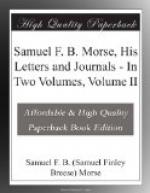A letter from his friend, Mrs. Jarvis, the sister of his erstwhile flame, Miss Jannette Hart, informs him of the marriage of another sister to Captain Hull of the navy, commander of the Constitution. In this letter, written on March 4, 1813, at Bloomingdale, New York City, Mrs. Jarvis says:—
“I am in general proud of the spirit of my countrymen, but there is too little attention paid to the fine arts, to men of taste and science. Man here is weighed by his purse, not by his mind, and, according to the preponderance of that, he rises or sinks in the scale of individual opinion. A fine painting or marble statue is very rare in the houses of the rich of this city, and those individuals who would not pay fifty pounds for either, expend double that sum to vie with a neighbor in a piece of furniture.
“But do not tell tales. I would not say this to an Englishman, and I trust you have not yet become one. This, however, is poor encouragement for you to return to your native country. I hope better things of that country before you may return.”
A friend in Philadelphia writes to him on May 3, 1813:—
“Your favor I received from the hands of Mr. King, and have been very much gratified with the introduction it afforded me to this worthy gentleman. You have doubtless heard of his safe arrival in our city, and of his having commenced his career in America, where, I am sorry to say, the arts are not, as yet, so much patronized as I hope to see them. Those of us who love them are too poor, and those who are wealthy regard them but little. I think, however, I have already witnessed an improvement in this respect, and the rich merchants and professional men are becoming more and more liberal in their patronage of genius, when they find it among native Americans.
“From the favorable circumstances under which your studies are progressing; from the unrivalled talents of the gentleman who conducts them; and, without flattery, suffer me to add, from the early proofs of your own genius, I anticipate, in common with many of our fellow citizens, the addition of one artist to our present roll whose name shall stand high among those of American painters.
“In your companion Leslie we also calculate on a very distinguished character.
“Our Academy of Fine Arts has begun the all-important study of the live figure. Mr. Sully, Mr. Peale, Mr. Fainnan, Mr. King, and several others have devoted much attention to this branch of the school, and I hope to see it in their hands highly useful and improving.
“The last annual exhibition was very splendid for us. Some very capital landscapes were produced, many admirable portraits and one or two historical pictures.
“The most conspicuous paintings were Mr. Peale’s picture of the ’Roman Charity’ (or, if you please, the ‘Grecian Daughter,’ for Murphy has it so), and Mr. Sully’s ‘Lady of the Lake.’”
In a letter of May 30, 1818, to a friend, Morse says:—




